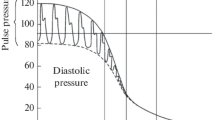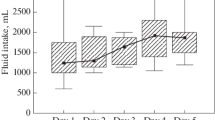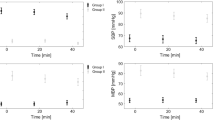Abstract
The hyperosmolarity-induced response of the ocular standing potential (SP) provides a method of testing the function of the retinal pigment epithelium (RPE) without using light stimulation.
In this study, the changes in potential level occurring after a short-term intravenous injection of 10 ml of 20% mannitol were determined by means of a direct current amplifier for the following groups: Group 1, normal rabbit eyes; Group 2, rabbit eyes in which the RPE was damaged by sodium iodate; Group 3, rabbit eyes in which the photoreceptors were damaged by monoiodoacetic acid; Group 4, rabbit eyes with uveoretinitis experimentally induced by Arthus-type inflammation.
The following results were obtained:
-
1.
The hyperosmolarity-induced SP response consisted of a transient increase in potential level (positive wave) in Group 1.
-
2.
For Group 2 a transient decrease in potential level (negative wave) was obtained, i.e., a reversal of the normal positive response to negative wave.
-
3.
A positive wave and no reversal was found for Group 3.
-
4.
For Group 4 a negative wave and a reversal of the normal response was obtained.
These hyperosmolarity-induced SP responses provide additional information concerning the possibilities of the method for studying the function of the RPE.
Similar content being viewed by others
References
Arden GB, Barrada A, Kelsey JH. New clincial test of retinal function based upon the standing potential of the eye. Br J Ophthalmol 1972; 46: 449–467
Arden GB, Kelsey JH. Changes produced by light in the standing potential of the human eye. J Physiol 1962; 161: 189–204
Ashburn FS Jr, Pilkerton AR, Rao NA, Mark GE. The effect of iodate and iodoacetate on the retinal adhesion. Invest Ophthalmol Vis Sci 1980; 19: 1427–1432
Inomata K, Tazawa Y. Effects of some drugs on ERG and standing potential of rabbit eye. J Iwate Med Assoc 1965; 17: 238–244
Kawasaki K, Madachi S, Yonemura D. Electrophysiological approach to clinical test for the retinal pigment epithelium. Acta Soc Opthalmol Jpn 1977; 81: 1303–1312
Kawasaki K, Yonemura D, Tanabe J, Madachi S, Kawaguchi H, Nakazato H. Approach to differential diagnosis of some macular dystrophies by new electrophysiological test. Folia Ophthalmol Jpn 1979; 30: 116–124
Lansanky A, De Fisch FW. Potential current and ionic fluxes across the isolated retinal pigment epithelium and choroid. J Gen Physiol 1966; 49: 913-d924
Madachi-Yamamoto S. Abolition of the light rise by aspartate. Acta Soc Ophthalmol Jpn 1980; 84: 607–616
Madachi-Yamamoto S. Electrophysiological evaluation of retinal pigment epithelium for clinical use. (I) Hyperosmolarity response of the standing potential and its origin. (II) Hyperosmolarity response in normal subjects. (III) Clinical study in several chorioretinal diseases. Acta Soc Ophthalmol Jpn 1982; 86: 374–413
Masuyama Y. Ultrastructural studies on the chorioretinal barrier of rabbit eye. Acta Soc Ophthalmol Jpn 1976; 80: 584–597
Miller SS, Steinberg RH. Passive ionic properties of frog pigment epithelium. J Membr Biol 1977a; 36: 337–372
Miller SS, Steinberg R. Active transport of ions across frog retinal pigment epithelium. Exp Eye Res 1977b; 25: 235–238
Miller SS, Steinberg RH, Oakley B II. The electrogenic sodium pump of the frog retinal pigment epithelium. J Membr Biol 1978; 44: 259–279
Mita T, Inomata K, Sugawara Y, Sato T. Studies on the standing potential of the retina in rabbit and cat. Jpn J Physiol 1969; 19: 360–372
Mukoh S. Electrical response of the retinal pigment epithelium to hyperosmolarity. Acta Soc Opthalmol Jpn 1985; 89: 482–497.
Nilsson SEG, Knave B, Persson HE. Changes in ultrastructure and function of the sheep pigment epithelium and retina induced by sodium iodate injection. Acta Solc Ophthalmol Jpn 1977; 69: 440–460
Noell KW. The origin of the electrogram. Am J Ophthalmol 1954; 38: 78–93
Noell KW. Cellular physiology of the retina. J Opt Soc Am 1963; 53: 36–48
Nomura T, Inoue Y, Furukawa H, Yamana Y, Kurimoto S. Morphological changes of retinal pigment epithelium in the experimentally produced choroiditis. Acta Soc Ophthalmol Jpn 1980; 84: 923–930
Oakley B II. Potassium and photoreceptor-dependent pigment epithelium hyperpolarization. J Gen Physiol 1977; 70: 405–425
Okinami S, Ohkuma M. Ultrastructural alterations in the retinal pigment epithelial cells of the monkey after systemic urea injection. Acta Soc Ophthalmol Jpn 1977; 81: 743–754
Shibata N. Effects of L-cysteine of the ERG and standing potential of the rabbit's eye. Acta Soc Ophthalmol Jpn 1977; 81: 452–471
Steinberg RH, Miller SS. Aspect of electrolyte transport in frog pigment epithelium. Exp Eye Res 197; 25: 235–238
Steinberg RH, Schmidt R, Brown KT. Intracellular response to light from cat pigment epithelium. Origin of the electroretinogram c-wave. Nature 1970; 227: 728–730
Suyama T. Electron microscopic study on experimental retinal degeneration by sodium iodate injection. Acta Soc Ophthalmol Jpn 1965; 69: 440–460
Suzuki E. The standing potential of experimental uveoretinitis in adult domesticated rabbits. Folia Ophthalmol Jpn 1984; 35: 1495–1501
Yamada M. Electrophysiologic assessment of ocular standing potential with mannitol and Diamox in adult rabbits. Folia Ophthalmol Jpn 1985; 36: 297–305
Yonemura D, Kawasaki K, Tanabe J, Yamamoto S. Susceptibility of the standing potential of the eye to acetazolamide and its clinical application. Folia Ophthalmol Jpn 1978; 29: 408–416
Author information
Authors and Affiliations
Rights and permissions
About this article
Cite this article
Yamada, M., Suzuki, E., Kikuchi, G. et al. The hyperosmolarity-induced response of the ocular standing potential in mature rabbits. Doc Ophthalmol 66, 347–358 (1987). https://doi.org/10.1007/BF00213663
Issue Date:
DOI: https://doi.org/10.1007/BF00213663




